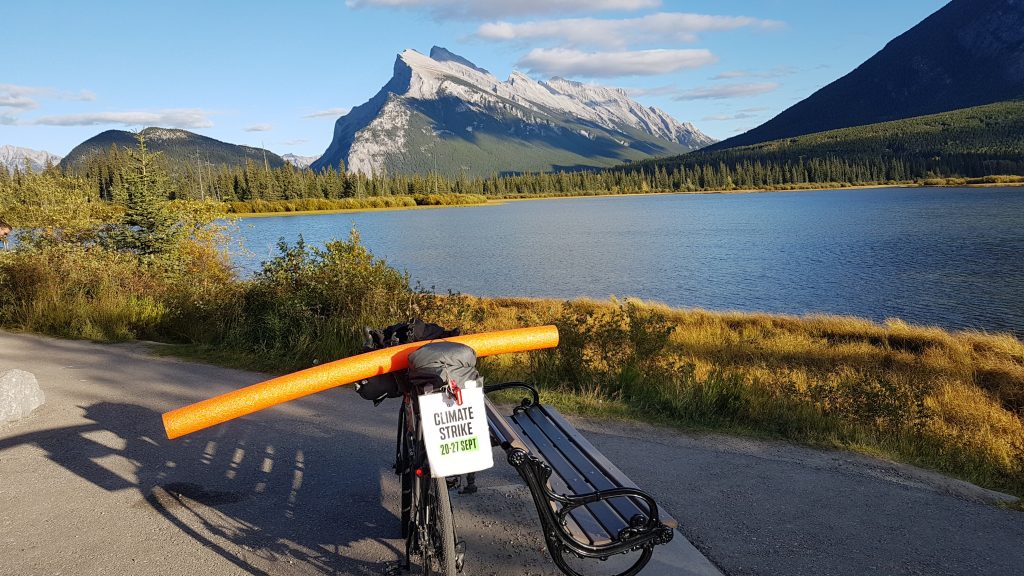
Suddenly my bike started sliding around, and it felt heavier than before. I tried to push harder. It did not work. Just to the opposite: Everything stopped moving. I was stuck, stuck in the mud. That’s not what I expected. I expected an easy day, mostly downhills on dirt roads. Yes, they gradually got wetter. But it didn’t rain that much, did it? I roughly cleaned the bike and tried again. Less than a meter and I was stuck again. Pushing the bike didn’t fare much better. There is no easy way out of here. The next signposts of civilization were about forty kilometers away. Ah yes, civilization: Isn’t it an excellent metaphor for our very culture, I thought. Pushing harder and harder in burning ancient old fossil fuels in our quest for endless growth. And what are we getting: stuck in the very consequences such as global warning? Except we knew what to expect. The debate about global warming was essentially settled in the 1970s.
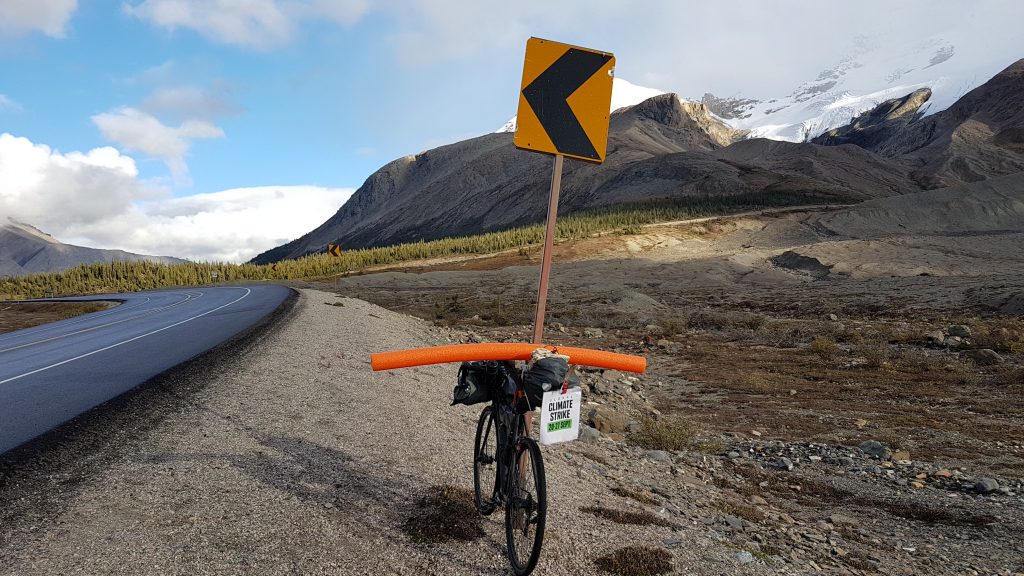
I was on the fourth day of a bike ride from Jasper, Alberta, Canada to Whitefish, Montana. It was my return ride to the States. I also called it my lonely Climate Strike Ride, as I happened to start it on Friday, September 20. Coinciding with the Global Climate Strike – where record 7.6 million people take to the streets in the most prominent climate mobilization in history – I spend six days of cycling. To catch a train later, that would lead me via Seattle and Los Angeles to Southern California – another three days. I put a make-shift, roughly water-proofed Climate Strike sign on my saddlebag. Just below the orange pool noodle meant to force drivers to keep the distance. It worked. The pool noodle I mean. Mostly, however, it worked in drawing attention. No one passing me failed to notice me, and everyone wanted to talk about the pool noodle. Surprisingly nobody wanted to discuss Climate Strike or Global Warming. Folks wanted to enjoy their holidays, after all, I guess. (But at least the noodle made sure everyone had to notice it nevertheless.) Drivers congratulated me on what a great idea it was to cycle around with an orange pool noodle, so they could not fail to see me! I usually told them I thought it was a bad idea, it would be a much better idea if drivers didn’t feel like kings of the road and watched out for other human and non-human beings. Usually, that ended the conversation quickly.
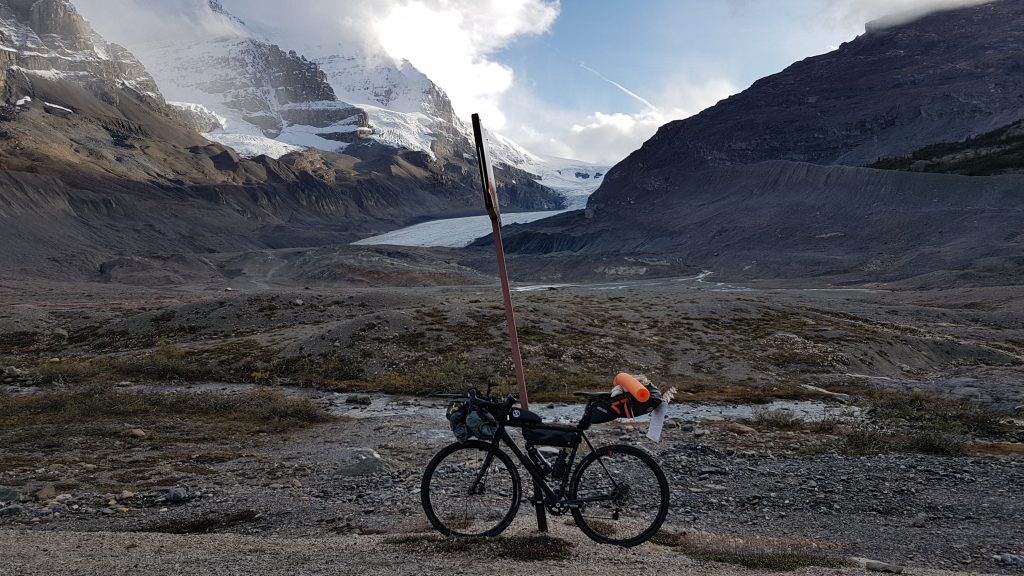
The first two days lead me along Icefield Parkways from Jasper to Lake Louise. Many say it’s one of the most scenic and spectacular roads in the world. As its name suggests, it passes
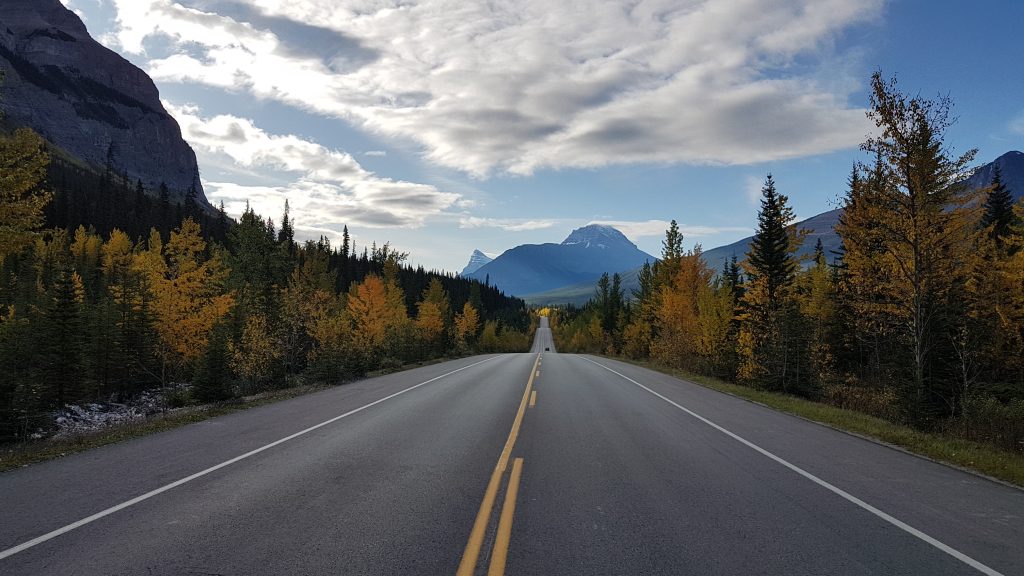
Either way you pay for the scenery and the scenery was magnificent. The parkway parallels the Continental divide and is named after features such as the Columbia Icefield – the largest icefield in the Rocky mountains and amongst the largest icefields south of the polar circles. It feeds six glaciers and Alberta’s and British Columbia’s tourism: about 100.000 vehicles pass by there in a summer month. They offer you unique experiences
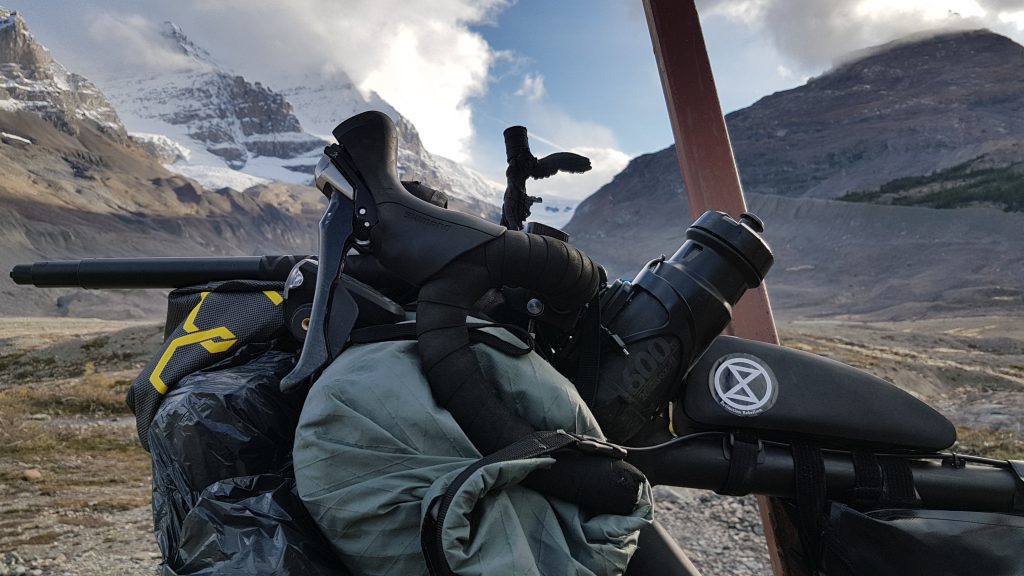
I stay overnight in a wilderness hostel just about halfway between Jasper and Banff. Darkness settles down as I arrive. It’s a pretty cool off-grid kind of space, next to Rampart creek. It runs electricity by solar and water turbine for powering lights and charging devices. It does not have hot water or showers, but it has a sauna and, of course, you can pay for sleeping in the wilderness by credit card. The guy running the space is clearly a cyclist. He admires my gear and portrays my next leg by meticulous detail: section lengths and exact grades. The next day I just need to follow his clues and continue to Lake Louise. Some more logistical things to notice about the Icefield parkway: There is one gas station about halfway (about 126km) and a restaurant each approximately fifty kilometers, which fits my pace quite well. Two passes are leading up to roughly around 2000 meters elevation before heading down to around 1400 meters again.
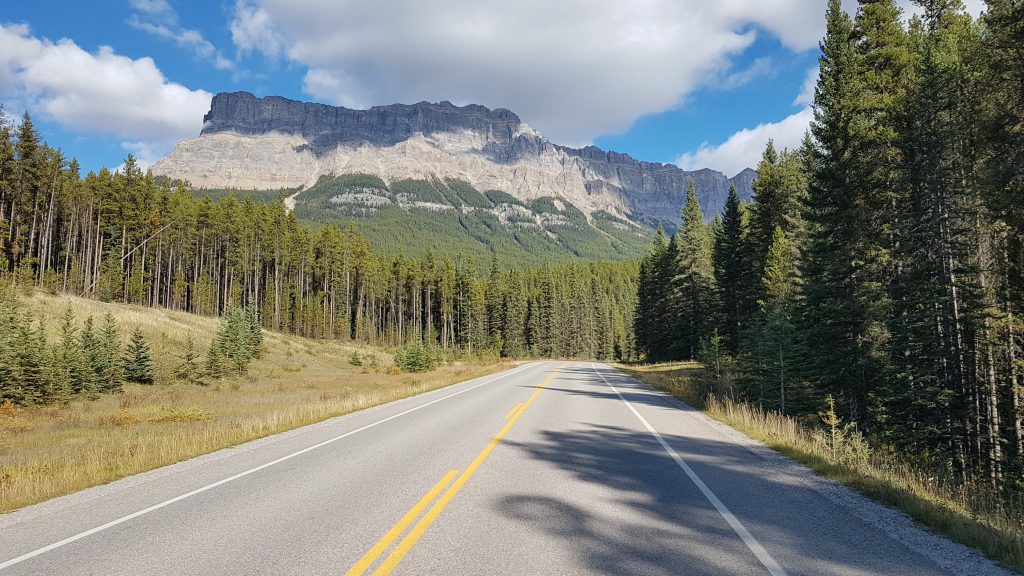
From Lake Louise it’s another 60 kilometers mostly along the – also very scenic – Bow Valley Parkway. It’s well known for meeting bears, but unfortunately, I didn’t spot any. Half of the parkway is closed due to re-pavement, and I have to sidetrack on the Trans-Canada Highway, which has at least one advantage: It helps my pace: On freeways, you can not also drive your car faster, you can also cycle faster. I am all in for turning them into cycling highways.

After a night in Banff, the most remote part of this ride follows: From Banff to the next town, restaurant or even grocery store it’s more than 100 miles (There should have been a camp site’s trading post halfway in, but it turned out it had already closed down for the season) and not only off-grid but also off-pavement: I mostly followed the Great Divide Mountain Bike Trail. From dusty gravel highways to dirt and fire roads that unexpectedly turned into singletrack trails, I find about every conceivable road condition. It’s also the most scenic part of the trip, riding on trails caught in between the lakes and the peaks, through burned forests and landscapes void of humans. After a final climb over Elk Pass, the highest point of the day – and the rest of the trip – I check into a cabin run by the Alpine Club Canada for a warm an cozy night. Too warm to be honest, the wood stove turned out to be really effective.

During the night it started raining outside. And then on day four, I am on my way down: Stuck in the mud! I eventually did find my way out. I had to carry my bike for a kilometer or two, to touch firm ground again. Sooner or later, the roads turned dry. In the end, I was lucky: I don’t want to imagine more copious amounts of rain. It could have taken me maybe two days of hiking out there, all while carrying a bike and luggage. Or perhaps someone would have passed by; I wasn’t alone out there, I met about a car a day …
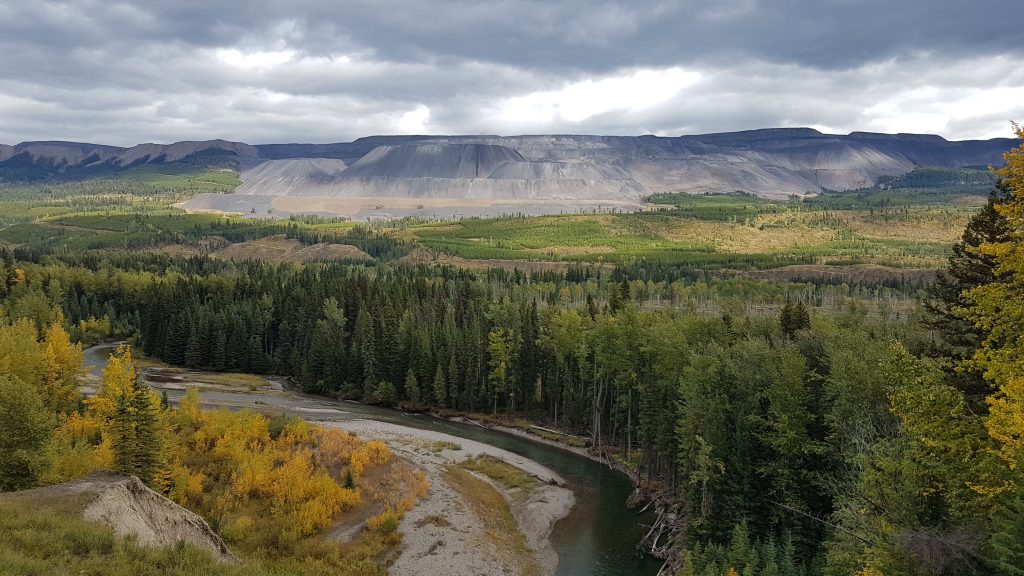
I hit pavement again at Elkford, just after passing an enormous open-pit coal mine. I am in coal country now. The Elk Valley is not really known for its beauty, though beauty it is. The area around Elkford and Sparwood
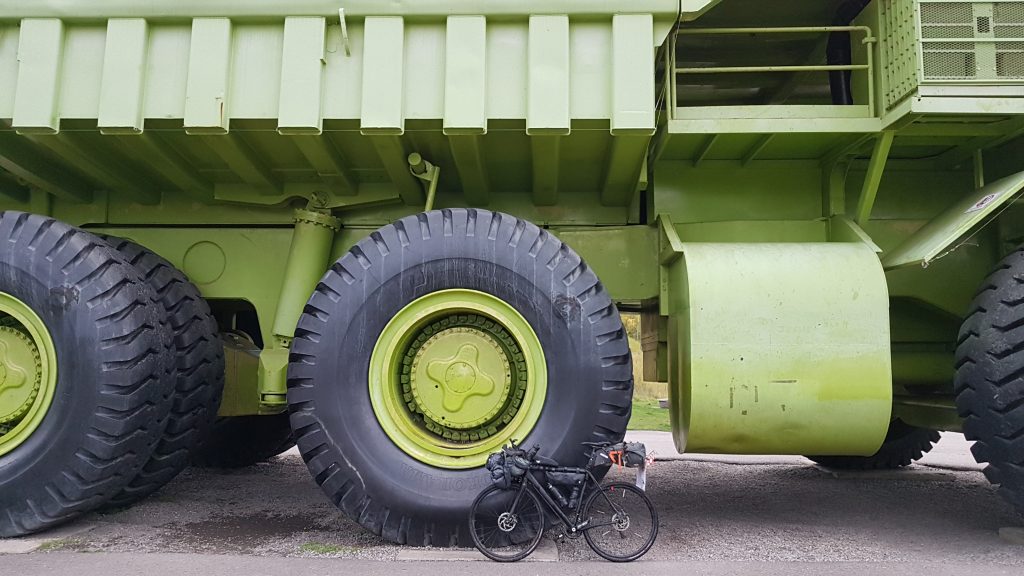
Elkford is a dull mining town, but I found a restaurant and – by virtues of globalization – it was a Chinese restaurant. So I feasted on chicken with vegetables and rice. I would have feasted on Burger or dog food, so hungry I was. Just a bit later, I arrived in Sparwood, which turned out to be another dull mining town, but a bit larger. I found myself a motel and another Chinese restaurant. It served Mapu Tofu and it pretty much resembled the chicken with vegetables a few hours before.
The other thing I did not fail to notice here: Nobody is driving a car, everyone drives a truck. There is plenty of oil around so why not lead a wasteful lifestyle? Two tons of steel carrying a person and a (disposable) cup of coffee.
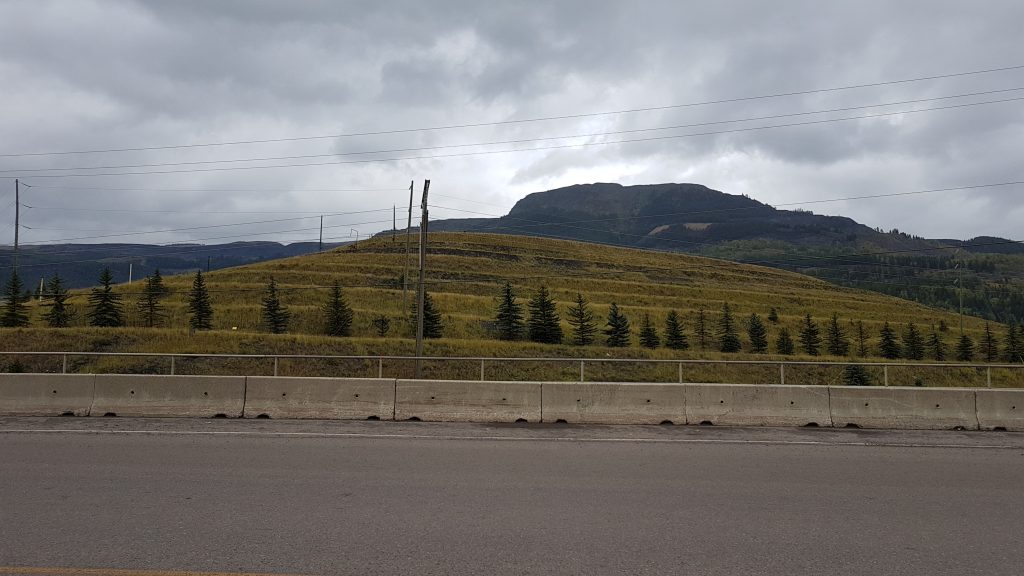
The next day I set out towards the United States mostly on highways, except for a 40 kilometers stint on a dirt road, mostly leading through logging areas. As it was raining again, I got my bike and myself allover muddy again. Luckily I did not get stuck (I was smart enough to turn around for a safer road when I suddenly hit a bad trail). A stretch of highway, a flat tire, and two gas stops later, arrived at the border. U.S. Customs let my dirty bike – and the Canadian pool noodle – pass, the weather suddenly turned sunny and beautiful, and I set for the night in a motel in Eureka.
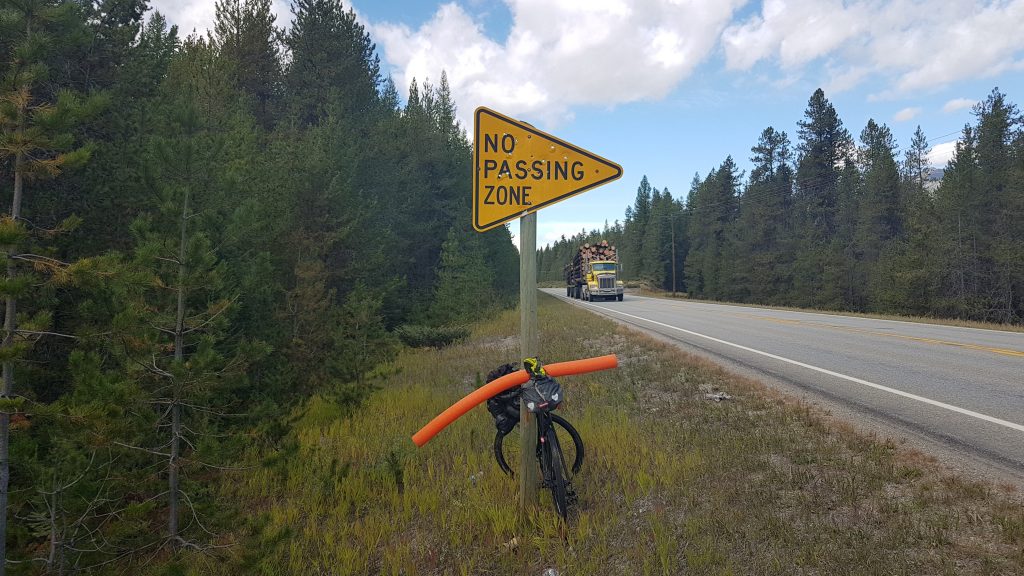
I had a massive breakfast at Cafe Jax, then cruised down sticking to highways, mostly without stops, except for coffee of course, and some delicious fish and chips. Though beautiful, Montana looked a bit boring given the scenic landscapes, I was just coming from, and they had amazingly creative names for their mountains, such as Big Mountain for something that looked like a big hill (It was actually a ski resort and topped 2000m elevation). I fluctuated between excellent coffee and delicious food and meeting white supremacists, Glock-fans, and Nazis. Given these facts, Montana pretty much resembled the country I come from: Austria. Both Glock and Hitler were Austrians after all. I felt at home immediately and could not wait to take the first train out of there. That train led me to Seattle.
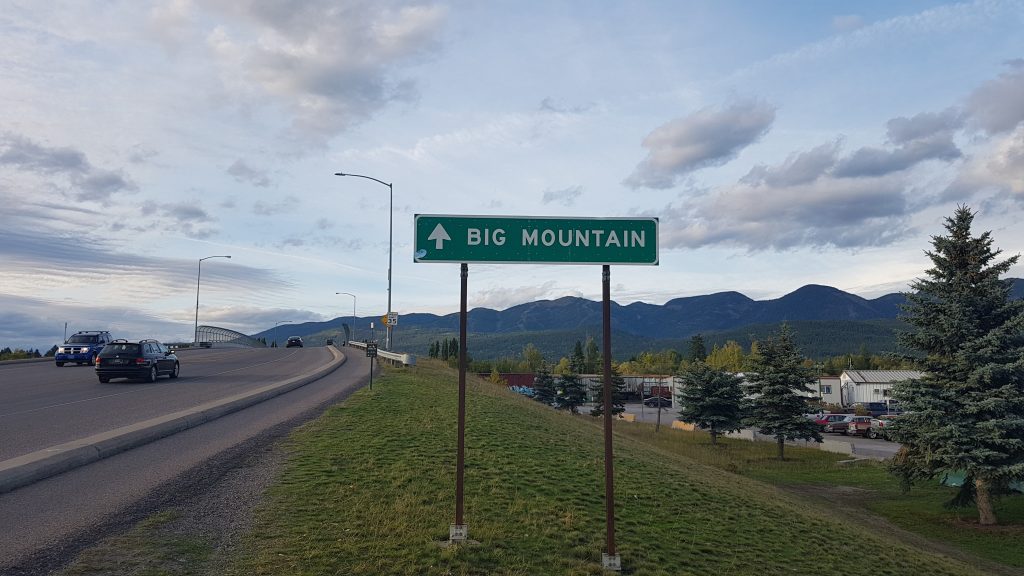
Grabbing a Seattle Times at King Station, the first headline I catch is: “Last year, income inequality in the United States reached its highest level since the Census Bureau started tracking it in 1967. ” I just finished cycling along the Continental Divide – the so-called-called Great Divide – here a find the real divide, the divide that actually matters, the divide that’s at the root of climate change: “The domination of the other-than-human world by humans is predicated on the domination of humans by humans, and thus any ecological claims must be rooted in social change“. There is no straight line drawn by the fate of humanity from the invention of fire to the burning of fossil fuels as the dominant techno-utopian, a capitalist paradigm of the Anthropocene is trying to tell us: “Global warming is an engineering problem“(Ironically caused – amongst others – by engineering). Ninety percent of the current human population has never seen an airplane from inside and never will. Whereas we now also know that it’s just about a hundred companies that are directly responsible for more than 70 percent of the cumulative greenhouse gas emissions. Of course, they made massive profits, which enabled them to spend billions of dollars on brainwashing politicians and people alike. The steam engine powered by coal kick-started the fossil fuel-powered-powered era. It did so, not because it was more efficient (it wasn’t) or cheaper (it wasn’t) than renewable energy sources already well known in the 18th and 19th century such as water and wind. It did so because it allowed manufacturers and capitalists to build their factories where the exploitable labor is. The fossil fuel infrastructure was built to exploit: resources, humans, and non-humans alike. And that is, what it still
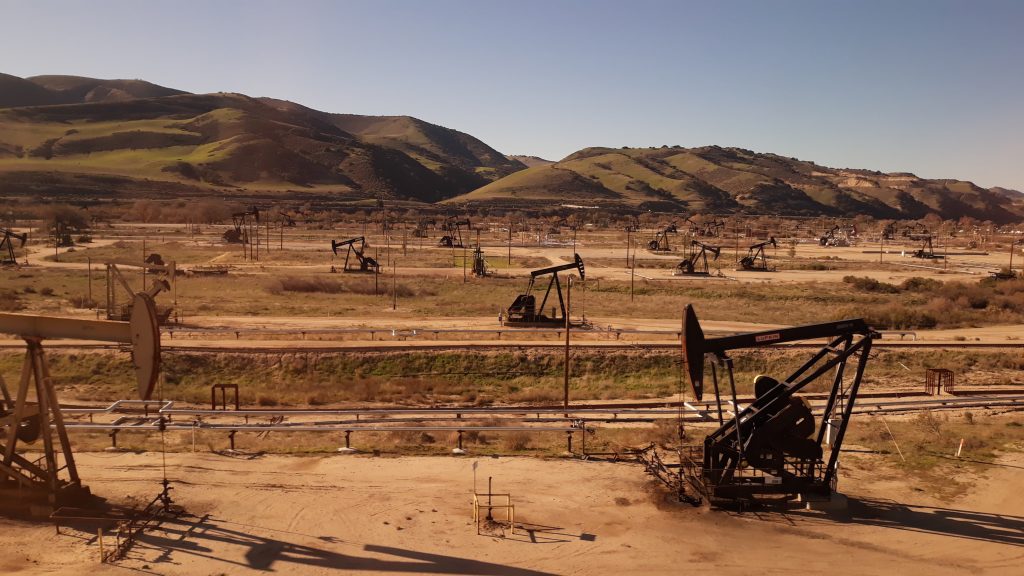
On my last leg of the train ride, I sit in the dining car while the train slowly moves through Salinas Valley. I look out of the window and see vast fields of agriculture, followed by oil pumps, and some patches of left-over nature towards the end of the valley. I share the table with a retired couple, that lived nearby. They owned a house in this very valley. We chatted a bit and they tried to show me their house. Why are they riding the train? After driving through the valley thousands of times by car they felt the need to change the perspective a bit and took a train for the first time in their life. Just so that they can see the area from a different point of view. It’s great they did it. Their children and grandchildren won’t have that much time though.
Sources and References:
Books:
- Andreas Malm: Fossil Capital: The Rise of Steam-Power and the Roots of Global Warming; Verso Books
- Christophe Bonneuil, Jean Baptiste Fressoz: The Shock of the Anthropocene. The Earth, History and Us; Verso Books
- Matt Hern and Am Johal: Global Warming and the Sweetness of Life. A Tar Sands Tale; MIT Press
- T.J. Demos: Against the Anthropocenecene. Visual Culture and Environment; MIT Press
- Bill McKibben: Oil and Honey. The Education of an Unlikely Activist, Times Books
Articles
- Seattle Times: Income inequality in America the highest it’s been since Census started tracking it, data show (September 26, 2019), https://www.seattletimes.com/business/income-inequality-in-america-the-highest-its-been-since-census-started-tracking-it-data-show/
- New York Times: Keystone XL Pipeline Plan Is Approved by Nebraska Supreme Court (August 23, 2019), https://www.nytimes.com/2019/08/23/us/keystone-xl-pipeline-nebraska.html
- ETH Zürich News: How trees could save the climate (July 4, 2019), https://ethz.ch/en/news-and-events/eth-news/news/2019/07/how-trees-could-save-the-climate.html
- The Guardian: Neoliberalism has conned us into fighting climate change as individuals (July 17, 2017), https://www.theguardian.com/environment/true-north/2017/jul/17/neoliberalism-has-conned-us-into-fighting-climate-change-as-individuals
- The Guardian: Just 100 companies responsible for 71% of global emissions, study says (July 10, 2017), https://www.theguardian.com/sustainable-business/2017/jul/10/100-fossil-fuel-companies-investors-responsible-71-global-emissions-cdp-study-climate-change
- The Globe and Mail: Athabasca glacier melting at ‘astonishing’ rate of more than five meters a year (published May 25, 2014, updated 2018), https://www.theglobeandmail.com/news/national/athabasca-glacier-melting-at-astonishing-rate-of-more-than-five-metres-a-year/article18835512/
Studies and Reports:
- Teck Resources Limited: Operations, https://www.teck.com/operation
- Dr. Paul Griffin: CDP Carbon Majors Report. 100 fossil fuel producers and nearly 1 trillion tonnes of greenhouse gas emissions, https://climateaccountability.org/pdf/CarbonMajorsRpt2017%20Jul17.pdf